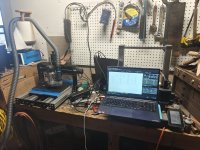Also: I've only used this thing to cut through some 1/2" plywood so far, but I recently picked up a laser engraver as well.
These things have gotten pretty cheap recently. The entire setup including the honeycomb board and air pump cost about 300 dollars. It's got a 10 watt output diode laser.
This gets around a lot of the difficulty with engraving and carving aluminum enclosures. The machine does not need to be nearly as rigid.
Important things to point out about laser engravers:
You're never going to engrave bare aluminum with a commercially available blue diode laser. Not gonna happen.
You can certainly *mark* aluminum. But you're going to need specialty laser marking paint or some dry moly lube to facilitate the process. Aluminum is reflective: it's not going to absorb the energy you're directing at it.
Also: ventilation. Super important. We're burning shit here. Nasty, poisonous fumes.
Lasers should be *perfect* for pre-painted enclosures, as they will burn off the powdercoat quite easily.
I'm currently struggling a little bit with mine: workpiece locating is a PITA. One of the primary advantages with lasers, though, is Lightburn. Seriously. I hear the developers of lightburn are making something for CNC routers, and I cannot wait.
Lightburn allows for webcam integration with accuracy within 1mm. That means you can stream a view of the workbench to your desktop and design directly on the surface of the enclosure. Pretty nifty.
I've got mine setup in the garage right now with a mini PC that I remote into. It's been going...eh...not great. That's primarily because of my wifi connection in the garage though. I've got a new adapter for the PC with a pair of high gain antennas to help with my connectivity issues.
In learning about lasers, there are three commercially available types:
Diode lasers. Cheapest. Typically on a gantry style syste. Anywhere from 5-80watt output. Big jump in cost between 10 to 20 watt. Typically operate in the visible spectrum, cannot directly engrave metals without a coating.
--sub category: infrared 1064nm diode lasers. Top out at 2 watts. About 2.5-3x as expensive as a 10watt laser, but can actually engrave bare aluminum. Slowly. *Very* slowly. So slowly that they're typically marketed for jewelry engraving. Not commercially viable, but certainly doable for DIY on 125b enclosures if you're OK with waiting.
CO2 lasers: dunno much about these. Typically gantry-based as far as I can tell. More expensive, and typically more powerful than diode lasers. Visible spectrum lasers, cannot typically engrave metal without a coating.
Fiber lasers: most expensive. Tend to be stationary with a "galvo" head (uses automated movable mirrors to direct the laser beam into the workpiece). *EXTREMELY* fast working. Tend to work in the 1064nm IR range and be more powerful than diode IR lasers. Some work in the visible range, some cheaper models are quite weak. The galvo head is both a blessing and a curse, as these tend to have the smallest workspace area of the bunch, and larger areas come with an increase in cost. There are some cheaper models that come with a trolley for extending one axis, but this slows down the operation considerably. Still, it might be the only way to pick one up that can do a bunch of different enclosures for under 3K.
--sub category: I've seen split fiber lasers with a gantry module connected to a power supply/laser generator via some cabling. These tend to be much more affordable (some under 1K) and far more powerful than the 2w IR diode laser modules. This seems ideal for DIY, as they pack about 10x the punch of the IR diode. Not as fast as a galvo model, but far more workspace area is opened up. Need to read more.
View attachment 80399






